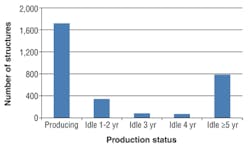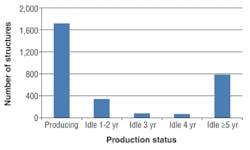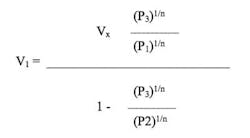GEOSCIENCES
Gene Kliewer • Houston
Reprocessing leads the way toward leasing, exploration
Spectrum has agreed with the Ministry of Energy and Energy Affairs in Trinidad & Tobago to reprocess 12,240 km (7,606 mi) of seismic data from the Trinidad and Tobago Deep Atlantic Area 2D survey taken off the eastern coasts of the islands. There are 39 blocks delineated in water depths between 1,000 – 3,500 m (3,281 – 11,483 ft).
The data are being processed in preparation for a Competitive Bid Round in the Deep Atlantic area. A decision is expected soon as to the number of blocks to be included in the bid round.
Spectrum’s primary reprocessing aim is to de-risk the deep/ultra-deep play targets that may be considered high risk by prospective exploration companies. Improvements in imaging will enable data ties into the shallow play area; and also provide key control. This will allow for extrapolation of successful shallow-play types as well as new plays into the deep/ultra deep area.The main advances in the reprocessing are the application of surface-related multiple elimination (SRME) and enhanced high-resolution Radon demultiple techniques. Much improvement is expected to be derived by careful velocity modeling, taking into account the significant geological changes from shallow to deep water areas; and allowing the identification of a slower, deep-velocity trend previously removed by an aggressive demultiple operator. Two passes of Kirchhoff pre-stack time migration provide better resolution of deeper structures.
Spectrum also has reprocessed 10,600 km (6,587 mi) of 2D multi-client seismic data from the geologically complex area offshore the Andaman Islands off eastern India. The project, under an agreement with the Directorate General of Hydrocarbons India, reveals several new structures and zones of interest.
The data extends across 245,000 sq km (94,595 sq mi) of Indian waters in the Andaman Sea, an area defined on the US Geological Survey as part of the Andaman Sea basin. The reprocessing shows that successful hydrocarbon exploration trends and analogues from adjacent basins may be extrapolated into this frontier area.
The data were reprocessed in both time and depth using techniques including SRME, high-resolution Radon demultiple, Kirchhoff pre-stack time and depth migrations, and various noise attenuation techniques. Issues including complex shallow geology (reefs and limestones) and steeply dipping events with angle and direction of dip variation within a small area had to be solved. There were improvements of the imaging of the entire seismic section, both shallow and deep.
The Indian section of the Andaman Sea basin is considered frontier in nature with only 15 wells drilled, all targeting the shallow water part of the fore-arc basin and most of them close to the Andaman Islands. Of these wells, the first (AN-01-1) discovered gas shows in Miocene limestones.
The reprocessing shows the basin contains all the elements for successful hydrocarbon exploration – likely source, reservoir, and seal intervals as well as structural and stratigraphic trapping geometries and direct hydrocarbon indicators such as gas clouds, bright and flat spots, and bottom simulating reflectors indicating gas hydrates.
Study comes to Suriname
INPEX Corp. has awarded OHM Rock Solid Images with a seismic attribute and facies classification study in Suriname block 31. The project incorporates seismic data from a 1,600 sq km (618 sq mi) 3D volume and log data acquired in a single well.
Rock Solid Images’ president of the Americas, Gareth Taylor said: “After a recently completed seismic inversion project in offshore Guyana and numerous similar projects in the emerging transform margin play of West Africa, we are excited to begin work with INPEX on this project. Our intimate knowledge of assessing rock property-driven seismic signatures via artificial neural networks to yield a reservoir characterization based on seismic facies should positively impact risk mitigation in this comparatively new and underexplored play fairway.”
Tow-boat under-shoot succeeds
The BGPPioneer successfully performed an under-shoot in the Gulf of Guinea using two vessels. This area covers the Ghana SALTPOND block, about 5 km (3 mi) offshore.
ThePioneer was the master vessel towing six streamers, and the source vessel was the Geo Mariner. The obstacle was an oil recovery platform of Ghana Oil Co. To acquire data under the platform, the crew adjusted the distances between the two vessels and at the same time kept operating along the lines. After the under-shoot, the site supervisor noted the success of the subsurface bin coverage under the obstacle, the integrity of the data, and the crew performance.
The under-shoot used a wireless bridge to exchange and transform the data simultaneously between both vessels.
Fugro gets newbuild seismic vessel
Fugro has taken delivery of the seismic survey vesselM/V Geo Coral. The vessel, owned by Fugro, is the last of four C-class vessel delivered to Fugro since 2007. Geo Coral, one of the largest and most advanced seismic vessels ever built, was outfitted at Bergen Yards in Norway.
Geo Coral is designed to operate in the most challenging areas, and can tow 16 seismic streamers. The design allows deployment of the largest possible spread of seismic streamers essential for efficiency on large prospects in the “high end” market segment.
SPECIFICATIONS
Length: 208 m (354 ft)
Stern width: 28 m (92 ft)
Class: DNV; +1A1, RP, E0, COMF C3 COMF-V3, CLEAN, NAUT AW, Helidk SH, ICE C
Streamers: Solid, 12.5 m group length, 16 x 7,200 m or 14 x 8,100 m max. capacity
Positioning: Primary navigation – Fugro Skyfix-XP DGPS; On-line navigation – Concept Systems Orca
Source: Sodera G-gun, single source up to 9000 cu. in, dual source up to 5,100 cu. in Seamap GunLink 4000 Digital Gun Controller
Recording: Sercel Seal, 24-bit digital system, Argus data recording, and online QC
Processing: Software: FSI SeisQC, FSI Uniseis; Hardware: Linux cluster and servers.
Offshore Articles Archives
View Oil and Gas Articles on PennEnergy.com


